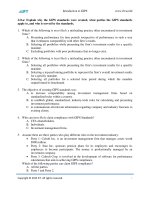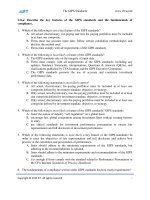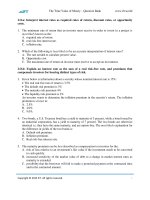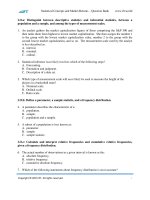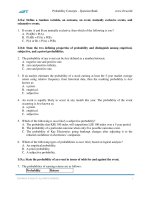CFA 2018 quest bank r40 portfolio management an overview q bank
Bạn đang xem bản rút gọn của tài liệu. Xem và tải ngay bản đầy đủ của tài liệu tại đây (209.78 KB, 6 trang )
Portfolio Management: An Overview – Question Bank
www.ift.world
LO.a: Describe the portfolio approach to investing.
1. Modern portfolio theory stresses the correlation between:
A. particular portfolio and a benchmark portfolio.
B. individual securities within a portfolio.
C. individual securities macroeconomic variables.
2. Ahmed Musa plans to invest in a number of assets to diversify his portfolio. This portfolio
approach will most likely result in:
A. Risk reduction.
B. Downside protection.
C. Risk elimination.
3. Three Level I candidates were discussing portfolio risk and returns and made the statements
shown below. Which candidate is most likely correct?
A. Candidate A: Portfolios impact returns more than risks.
B. Candidate B: Portfolios impact risks more than returns.
C. Candidate C: Portfolios impact both risk and return equally.
4. The diversification ratios of portfolios A, B and C are 0.5, 0.7 and 0.9 respectively. The
portfolio that provides the best diversification benefit is:
A. portfolio A.
B. portfolio B.
C. portfolio C.
5. If the average standard deviation of returns of n stocks is 30%, and the standard deviation of
returns of an equally weighted portfolio of the n stocks is 20%, then the diversification ratio
is closest to:
A. 0.66.
B. 1.5.
C. 0.5.
LO.b: Describe types of investors and distinctive characteristics and needs of each.
6. Which of the following institutional investors is most likely to have a low risk tolerance and
relatively high liquidity needs?
A. Endowments.
B. Defined benefit pension plans.
C. Insurance companies.
7. An analyst gathers the following information for the asset allocations of three portfolios:
Portfolio
1
2
3
Fixed Income (%)
30
45
15
Equity (%)
45
30
55
Alternative Assets (%)
25
25
30
Portfolio Management: An Overview – Question Bank
www.ift.world
Which of the portfolios is most likely appropriate for a client who has a high degree of risk
tolerance?
A. Portfolio 1.
B. Portfolio 2.
C. Portfolio 3.
8. Which of the following types of investors will most likely have the lowest need for income?
A. Mature defined benefit pension plan.
B. Insurance companies.
C. Investment companies.
9. Shakeel Shah manages a defined benefit plan for Acme Co. Acme has a large number of
retired employees. The fund is most likely to have a high need for:
A. liquidity.
B. income.
C. liquidity and income.
10. Analyst 1: Endowments typically have a long time horizon, a high risk tolerance and low
liquidity needs.
Analyst 2: Banks typically have a short time horizon, low risk tolerance and high liquidity
needs.
Which analyst’s statement is most likely correct?
A. Analyst 1.
B. Analyst 2.
C. Both.
LO.c: Describe defined contribution and defined benefit pension plans.
11. Which of the following is least likely a feature of a defined benefit pension plan?
A. The employer accepts the investment risk.
B. The employee accepts the investment risk.
C. The employer provides a specified retirement benefit.
12. Which of the following is least likely a feature of a defined contribution plan?
A. The employee accepts the investment risk.
B. The amount contributed by the employer is treated as an operating cash outflow.
C. The employer provides a specified retirement benefit.
LO.d: Describe the steps in the portfolio management process.
13. Sean McDonald, CFA, manages the portfolios of several clients. With respect to how
frequently the investment policy statement must be updated for a client, which of the
following is most likely true?
A. On regular intervals such as every six months.
B. Only if expectations about the market change.
C. Only if there is a major change in a client’s situation.
Portfolio Management: An Overview – Question Bank
www.ift.world
14. Which of the following regarding the portfolio management process is most accurate?
A.
B.
C.
Planning
Asset allocation
Execution
Security analysis
Understanding the
clients’ needs
Preparing an
investment policy
statement (IPS)
Preparing an investment
policy statement (IPS)
Portfolio construction
Feedback
Monitoring and
rebalancing
Portfolio construction
Performance
measurement and
reporting.
15. Junaid Jamshed is planning a portfolio for his client. In accordance with the planning step of
the portfolio management process, he is least likely to assess:
A. the client’s constraints.
B. the expected returns of various securities.
C. the client’s degree of risk averseness.
16. For a top-down security analysis, the first step is to:
A. examine macro-economic conditions.
B. identify the most lucrative companies within each industry.
C. analyze a firm's business projections and management quality.
17. With respect to portfolio management process, security selection decisions are made in the:
A. planning step.
B. execution step.
C. feedback step.
18. Which of the following is most likely a part of the planning step in the portfolio management
process?
A. Asset allocation.
B. Security selection.
C. Development of the investment policy statement.
19. The planning step in the portfolio management process includes:
A. deciding the asset allocation between equities, fixed income securities and cash.
B. preparation of an investment policy statement.
C. identifying attractive investments in particular market segments.
20. The feedback step of the portfolio management process does not include:
A. performance management.
B. asset allocation.
C. performance reporting.
LO.e: Describe mutual funds and compare them with other pooled investment products.
21. The distinguishing factor between a wrap account and a mutual fund is that with wrap
accounts:
Portfolio Management: An Overview – Question Bank
www.ift.world
A. investments cannot be tailored to the tax needs of a client.
B. there is a lower required minimum investment.
C. assets are owned directly by the investor.
22. Serene and Co. is characterized by a few large investments. Serene and Co. is most likely a:
A. hedge fund.
B. venture capital fund.
C. buyout fund.
23. Buyout funds and venture capital funds are similar in that, they both:
A. restructure companies to increase profitability.
B. expect only a small percentage of investments to pay off.
C. actively participate in the management of companies
24. A key
funds:
A.
B.
C.
difference between a venture capital fund and a buyout fund is that venture capital
make investments in established companies.
make large investments.
avoid the use of leverage.
25. Analyst 1: The minimum investment required to open a separately managed account (SMA)
is lower than that of a mutual fund.
Analyst 2: In a separately managed account (SMA) transactions can be tailored to the
specific needs of the investor.
Which analyst’s statement is most likely correct?
A. Analyst 1.
B. Analyst 2.
C. Both.
26. Which of the following is most likely true about exchange traded funds? ETFs:
A. can be sold short.
B. generally do not trade close to NAV.
C. can only trade on closing asset prices.
Portfolio Management: An Overview – Question Bank
www.ift.world
Solutions
1. B is correct. The main conclusion of MPT is that investors should not only hold portfolios,
but should also focus on how individual securities in the portfolios are related to one another.
2. A is correct. Combining assets into a portfolio should reduce the portfolio’s volatility.
However, the portfolio approach does not necessarily provide downside protection or
eliminate all risk.
3. B is correct. Portfolios reduce risk more than they increase returns.
4. A is correct. The lower the diversification ratio, the better the diversification.
5. A is correct.
=
= 0.67.
6. C is correct. Insurance companies tend to have a low risk tolerance and a high need for
liquidity given the necessity of paying claims when due. Endowments and defined benefit
pension plans typically have long time horizons and relatively high risk tolerance.
7. C is correct. Portfolio 3 has the highest equity and alternative investment exposure. These
asset classes have relatively high risk/return characteristics compared to fixed income.
8. B is correct. Income needs of individuals and investment companies vary depending on
varying needs. Insurance companies (both life and non-life) have lowest income needs
relatively.
9. B is correct. Shah must focus on income needs as income is necessary to meet the cash flow
obligation to retirees. For defined benefit plans, the need for liquidity typically is quite low.
10. C is correct. Both statements are correct.
11. B is correct. In a defined benefit pension plan, the employer provides a specified retirement
benefit and accepts the investment risk.
12. C is correct. In a defined benefit plan, a company makes promises of future benefits to be
paid to the employees.
13. A is correct. An IPS should be updated at regular intervals. Options B and C are not correct
because of the term ‘only’.
14. C is correct. Planning stage requires identifying/ understanding the needs of the clients and
preparing an investment policy statement (IPS), execution stage requires asset allocation,
Portfolio Management: An Overview – Question Bank
www.ift.world
security analysis plus portfolio construction and the feedback stage involves monitoring and
rebalancing.
15. B is correct. Securities are analyzed in the execution step. In the planning step, a client’s
objectives and constraints are used to develop the investment policy statement.
16. A is correct. A top-down analysis begins with an analysis of macroeconomic trends. After a
well-performing industry is selected, the most attractive companies comprising are then
identified.
17. B is correct. Security selection decisions are made during the execution step of the portfolio
management process.
18. C is correct. Security selection and asset allocation are a part of the execution step in the
portfolio management process.
19. B is correct. The planning step in the portfolio management process includes understanding
the client’s needs and preparation of an investment policy statement. Asset allocation and
security analysis are parts of the execution step in the process.
20. B is correct. Asset allocation is a part of the execution step of the portfolio management
process.
21. C is correct. The key difference between a wrap account and a mutual fund is that in a wrap
account the assets are owned directly by the individual.
22. C is correct. Buyout funds or private equity firms make only a few large investments in
private companies with the intent of selling the restructured companies in three to five years.
Hence, Serene and Co. is most likely a private equity firm.
23. C is correct. Both buyout funds and venture capital funds play an active role in the
management of companies.
24. C is correct. Venture capital funds make several small investments in start-up companies and
actively participate in the invested businesses providing advice. VC funds avoid the use of
leverage. Buyout funds use leverage.
25. B is correct. The minimum investment required to open an SMA is usually much higher than
that of a mutual fund. In an SMA, transactions can be tailored to the specific needs of the
investor.
26. A is correct. ETFs can be sold short, purchased on margin, and traded at intraday prices,
whereas open-end funds are typically sold and redeemed only daily, based on the share NAV
calculated with closing asset prices.



